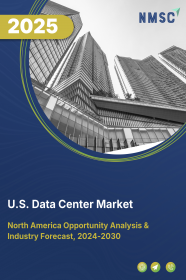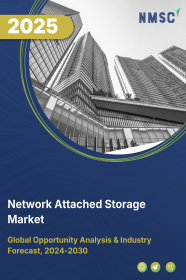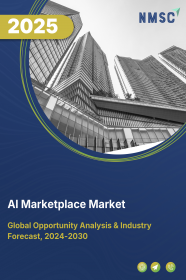
U.S. Data Center Market by Component (Hardware, Software, Service), by Type (Colocation, Hyperscale, Edge, Other Types), by Deployment Model (On-Premises, Cloud, Hybrid), by Tier Standard (Tier 1, Tier 2, Tier 3, Tier 4), by Energy Requirement & Power Density (Low Power, Medium Power, High Power), by Cooling Techniques (Air Cooling, Liquid Cooling, Others), by Enterprise Size (Large Enterprises, Others), by End User (BFSI, Other End Users)– Opportunity Analysis and Industry Forecast, 2024–2030
Industry: ICT & Media | Publish Date: 09-Apr-2025 | No of Pages: 173 | No. of Tables: 134 | No. of Figures: 79 | Format: PDF | Report Code : IC2420
US Tariff Impact on U.S. Data Center Market
Trump Tariffs Are Reshaping Global Business
U.S. Data Center Market Overview
The U.S. Data Center Market size was valued at USD 103.27 billion in 2023, and is predicted to reach USD 158.55 billion by 2030, at a CAGR of 6.3% from 2024 to 2030. The data center market, also referred to as the network infrastructure market, encompasses the planning, construction, operation, and upkeep of specialized infrastructure dedicated to hosting computing systems. It comprises various components such as servers, storage systems, and networking gear, providing services such as cloud computing and connectivity solutions. Presently, the industry is witnessing widespread adoption of cloud services, alongside the emergence of edge computing to minimize latency.
Key trends include an emphasis on sustainability, heightened cybersecurity concerns, the integration of hybrid and multi-cloud approaches, and the influence of 5G networks. These trends underscore the industry's response to the growing demand for scalable, efficient, and secure data processing and storage solutions in the era of digital transformation. According to the United States International Trade Commission, the data processing and storage market is projected to expand from USD 56 billion in 2020 to USD 90 billion by 2025.
Geographic Distribution and Market Dominance Propels the U.S. Data Center Market Growth
In the US, over 5,300 data centers are strategically distributed across the country. Northern California, in particular, serves as a hub for data-intensive companies, including Google, Facebook, Uber, Twitter, and Yelp. This widespread distribution of the market reflects the extensive integration of data into the US economy and the influence of cost-effective energy in various regions. Interestingly, the top 10 market locations account for less than 40% of all US market growth, highlighting the extensive geographic spread, with nearly every state hosting at least one facility. The industry is dominated by major operators such as Lumen Technology, Verizon, Digital Realty, AT&T, and Equinix, that collectively comprise 25.9% of all US market growth.
Additionally, a PwC report commissioned by the Data Center Coalition (DCC) revealed that the market growth contributed USD 2.1 trillion to the US GDP between 2017 and 2021. According to CloudScene, an Australian-based data intelligence firm, the US hosts 5,389 network infrastructure, significantly more than the UK's 512.
Investment and Expansion by Major Companies Fuels the U.S. Data Center Market Growth
The growing investment by major companies to expand their data centers across the US is fueling market demand. For instance, Amazon Web Services (AWS) invested USD 35 billion in new network infrastructure in Virginia, demonstrating a strong commitment to cloud expansion despite broader layoffs at Amazon.
This strategic move aims to create 1,000 jobs and strengthen AWS's long-term position in the cloud computing market. Such substantial investments underscore the importance of the market trends in supporting the digital economy and highlight the ongoing expansion and innovation within the industry.
High Initial Investment Hinders the Growth of the Market
The data center market faces significant obstacles, notably the substantial upfront investment required and strict environmental regulations. Establishing and maintaining network infrastructure demands considerable financial commitments upfront, posing barriers for smaller enterprises and startups. Moreover, ongoing compliance with environmental standards necessitates continual investments in energy-efficient technologies hinders the overall U.S. data center market growth.
Integration of Edge Computing Presents Lucrative Opportunity for Market Expansion
The integration of edge computing into the market operations presents compelling prospects for the industry's advancement. By minimizing latency and enabling real-time processing, edge computing supports applications such as Internet of Things (IoT) and Augmented Reality (AR), alleviating pressure on centralized cloud data centers while providing scalability and flexibility.
This decentralized approach not only enhances security by processing sensitive data locally but also aligns with evolving digital landscapes, paving the way for diverse opportunities for network infrastructure providers.
Recent investments in startups such as Armada signify the burgeoning interest in edge computing solutions, indicative of a concerted effort to address connectivity challenges and bridge the digital divide.
Competitive Landscape
The key market players operating in the U.S. data center industry include IBM Corporation, Amazon Web Services, Inc, Microsoft Corporation, Cisco Systems, Inc., Oracle Corporation, SAP SE, Hewlett Packard Enterprise Development LP, Broadcom Inc., EdgeConneX Inc., TierPoint, LLC, Digital Realty Trust, Equinix, Inc., Flexential Corporation, CloudHQ, QTS Realty Trust, LLC.
U.S. Data Center Market Key Segments
By Component
-
Hardware
-
UPS
-
Generators
-
Transfer Switches
-
Cooling Systems
-
Computer Room Air Conditioning (CRAC)
-
Racks
-
Others
-
-
Software
-
Services
By Type
-
Colocation
-
Hyperscale
-
Edge
-
Other Types
By Deployment Model
-
On-Premises
-
Cloud
-
Hybrid
By Tier Standard
-
Tier 1
-
Tier 2
-
Tier 3
-
Tier 4
By Energy Requirement and Power Density
-
Low Power (Less than 20MW)
-
Medium Power (20-100MW)
-
High Power (100MW and More)
By Cooling Techniques
-
Air Cooling
-
Liquid Cooling
-
Dry Cooling
-
Immersion Cooling
-
Others
By Enterprise Size
-
Large Enterprises
-
Small and Medium Enterprises
By End User
-
BFSI
-
IT and Telecom
-
Government
-
Energy and Utilities
-
Other End Users
Key Players
-
IBM Corporation
-
Amazon Web Services, Inc
-
Microsoft Corporation
-
Cisco Systems, Inc.
-
Oracle Corporation
-
SAP SE
-
Hewlett Packard Enterprise Development LP
-
Broadcom Inc.
-
EdgeConneX Inc.
-
TierPoint, LLC
-
Digital Realty Trust
-
Equinix, Inc.
-
Flexential Corporation
-
CloudHQ
-
QTS Realty Trust, LLC
REPORT SCOPE AND SEGMENTATION:
|
Parameters |
Details |
|
Market Size in 2023 |
USD 103.27 Billion |
|
Revenue Forecast in 2030 |
USD 158.55 Billion |
|
Growth Rate |
CAGR of 6.3% from 2024 to 2030 |
|
Analysis Period |
2023–2030 |
|
Base Year Considered |
2023 |
|
Forecast Period |
2024–2030 |
|
Market Size Estimation |
Billion (USD) |
|
Growth Factors |
|
|
Companies Profiled |
15 |
|
Market Share |
Available for 10 companies |
|
Customization Scope |
Free customization (equivalent up to 80 working hours of analysts) after purchase. Addition or alteration to country, regional, and segment scope. |
|
Pricing and Purchase Options |
Avail customized purchase options to meet your exact research needs. |

















 Speak to Our Analyst
Speak to Our Analyst





















